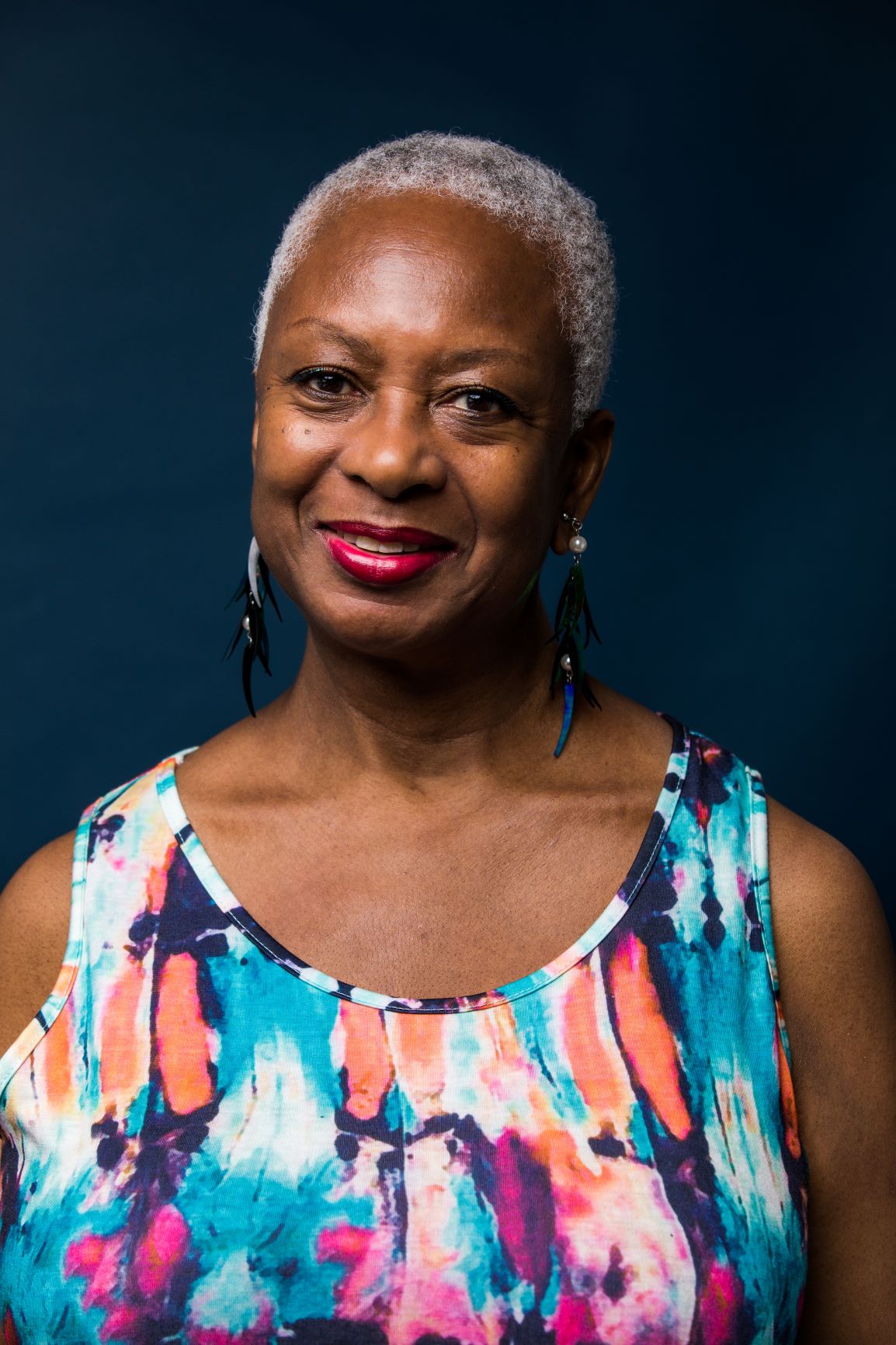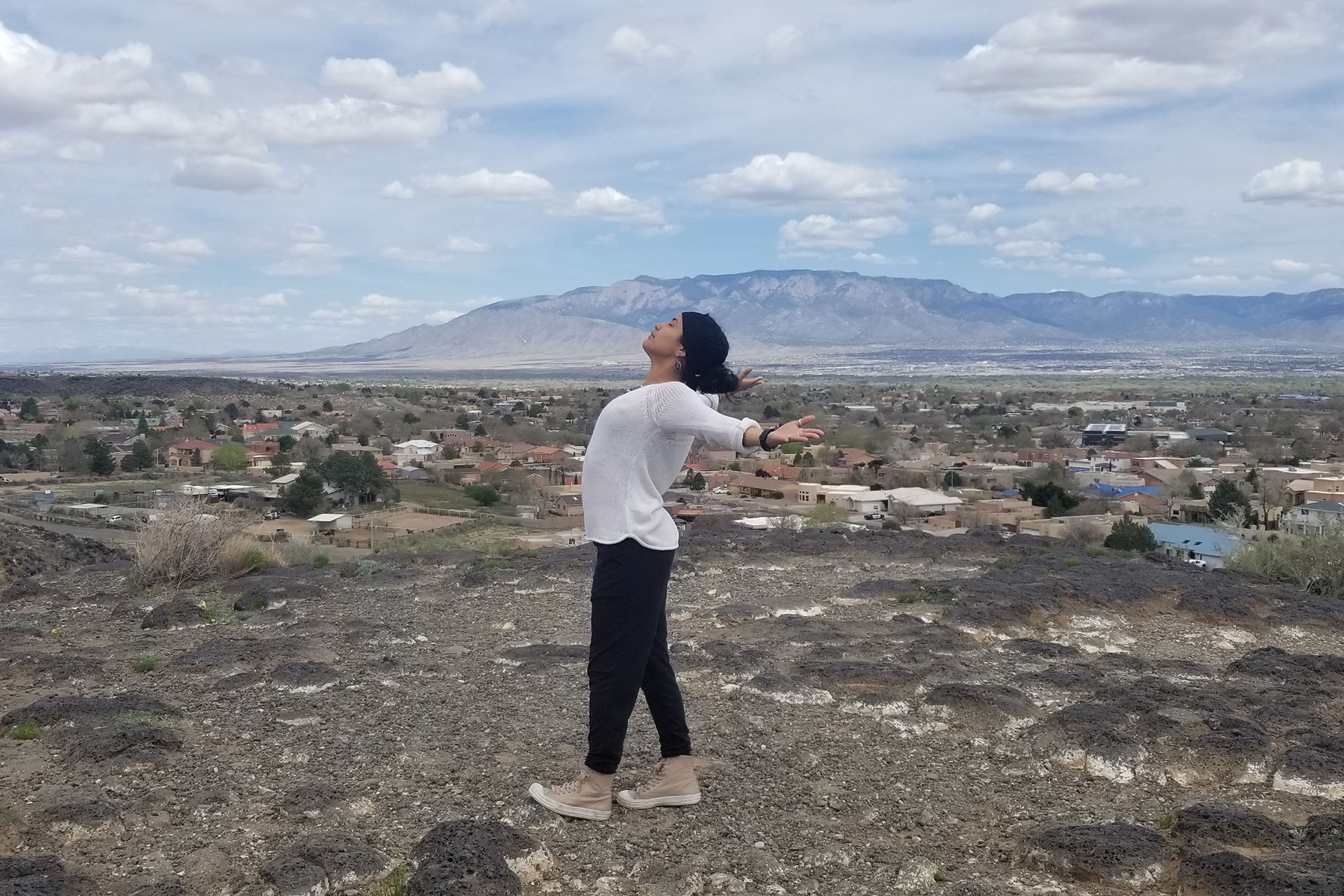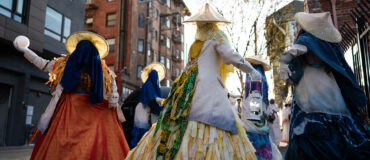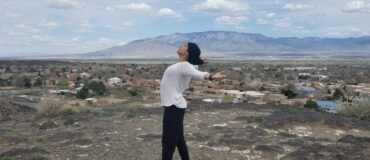How We Build
Holly Bass, Deneane Richburg, and Paloma McGregor
By Eva Yaa Asantewaa
Editor’s note: This article is one of 11 in a series examining the creative work of 31 dance artists funded by Dance/USA Fellowship to Artists, generously supported by the Doris Duke Charitable Foundation. These artists’ practices are embedded in social change as they work in multiple dance forms in communities across the country.

Paloma McGregor describes Building a Better Fishtrap as a ritual to honor and embody the stories and spirit of the Bronx River. The collaborative, multi-year project brought together dozens of artists and community members in significant spaces around New York and beyond. Photo: Charles R. Berenguer, Jr.
Holly Bass, Deneane Richburg, and Paloma McGregor have each made innovative dance work sourced in cultures, stories and social justice concerns of the Black diaspora. These choreographers uphold the role of the dancing body as a repository of personal, communal and ancestral experience; a tool of questioning and research; and a vessel of healing grace.
With each, I inquired about their internal creative processes as well as their relationship to community — and, of course, the overlap in their engagement with collaborators and communities as they create.
I chose to focus on the following questions:
What grounds your work? What propels your work? As grains of sand irritate an oyster into forming a pearl, which irritants spur your creative process? What draws you toward a particular creative tool or modality? What is pleasurable and joyful about your practice? How is the development of your work informed by outsiders’ perceptions of it? What have you learned about your audiences? How does social practice and social justice enter into your practice? To whom do you hold yourself accountable and why?
The reporting for this article began during the 2020 coronavirus shutdown and was submitted a little more than a week after the police murder of George Floyd in Minneapolis set off worldwide uprising. In those early days, my own emotional vulnerability led me to avoid returning to these interviewees — especially the Twin Cities-based Richburg — for statements on the current situation. Instead, I believe this article, and its portraits of three accomplished Black women, stands as a rebuke to all who resist the truth that Black lives matter, and as nourishment for anyone on the path to creativity and justice in a world crying out for more of both.
HOLLY BASS

A multidisciplinary artist who works in performance, visual mediums and poetry, Washington, D.C.-based Holly Bass makes pieces that confront issues of labor, precarity, and feminism. Photo: Pamela Janzesian
Holly Bass thinks about Khoikhoi Sara “Saartjie” Baartman enduring long hours on freak-show display for the European gaze in the 18th century; Ginger Rogers dancing backwards in high heels; and Beyoncé’s agile drummers in their “big-ass heels and makeup.” Her work confronts issues of labor, precarity, and feminism with pop’s clever appeal. With the pandemic shutdown of New York City arts venues in the spring of 2020, Bass revised her latest in-process showing of the work Race by streaming views of its separated trio of homebound performers on New York Live Arts’ Facebook page.
“This moment of quarantine has been a kind of ungrounding in many ways, forcing all of us to question how we create work, how we move through the world, what are our core values,” Bass explained from her home in Washington, D.C. “When I set out to make Race, about three years ago, I was thinking about the disconnect between the general public and avant-garde art.”
In creating the evening-length Race, with its interactive elements for audiences who serve as the cheering section and are required to vote for one of two dancers, Bass was focused on the interplay of the work with audiences. “I was thinking about how everybody loves sports. Even if you don’t love sports, you might go to a baseball game with your friend,” Bass said, “because there’s something fun about being in the stands with people you love and about sharing, even if you’re not invested in the team.” But with postmodern dance, she said, “If somebody saw one performance, and they hated it, they wrote off the entire genre! I wanted to break down that barrier to access.”
Bass approaches her work with a scientific curiosity, seeking to understand more about other human beings and more about herself. “What I love about live performance,” she said, “is that there’s that risk of something going wrong or something changing. There’s also that wonderful infusion of energy that comes from people responding to you in real time. Performance art and live performance, as modalities, are never stale.” Digital art, she pointed out, has a different goal. “I could make a digital art piece, and play it in the gallery. Maybe somebody will post something on social media so that I know it has had an impact. But live, in front of people, I can see someone’s face, I can hear their voice.”
Raised in the Southern Black church tradition of call and response, Bass recalled worshipping together as she continues to draw on that modality in her work.
SOCIAL JUSTICE NOT JUST ON STAGE, BUT IN THE CREATIVE PROCESS
Asked what propels her work, Bass said, “In a practical way, outside partnerships, outside deadlines, a desire to collaborate. And then, internally, what propels the work is the real desire to be in community — particularly with Black women artists, providing paid opportunities for Black women artists. How can I support other women artists like me?”
She explicitly calls herself a social-justice-oriented artist: “A cultural organizer, part of a legacy that includes people like Toni Cade Bambara, Audre Lorde, Gwendolyn Brooks. Brooks, not just for her poetry, but for the way she would answer every letter that was sent to her from every poet in jail, high school, wherever. At the peak of her success, she chose to publish with Third World Press, a small independent Black publisher, rather than the big publishers who were now willing to present her work.”

Bass describes Race: TBD as a performance about gentrification, race and class. Designed like a sporting event with a tailgate party and live commentators, like many of her works, it’s sharp-edged but not didactic. Pictured: Jasmine Hearn, Bass and Billy Dean Thomas. Courtesy: H. Bass
Bass is committed to not just developing her own career trajectory, she is also intent on creating opportunities that support fellow artists, especially women of color. She asks, “How can I cultivate multiple resources and outlets — for myself, for younger artists, for older artists, for a generation of artists I drew inspiration from who may not be getting the recognition or funding?”
She is mindful of challenges Black women artists face, especially mothers. “In previous pieces, I would get child care so that we could rehearse in the studio, and the kids could all be in a room playing together,” Bass noted. “A lot of people have social justice on the stage, but it’s not necessarily how they treat their collaborators and their workers. There has to be alignment, and I want people to hold me accountable for that.”
Bass learns much from her audiences: “The more vulnerable I make myself, the more seen and heard and recognized they feel. The more I can open up my heart and create intimacy, the more powerful it becomes for those audiences.”
DENEANE RICHBURG
Deneane Richburg counts, among her honors, gold medals in competitive figure skating, a 2019 Jerome Hill Artist Fellowship, and a 2017 McKnight Choreography Fellowship. Her Minneapolis nonprofit, Brownbody, fuses the technical skill of figure skating with theater and dance’s freedom of physical and narrative expression. Richburg dedicates her work to revealing how Black bodies can use nuanced movement and the agile tilt and rock of blades on ice to tell powerful stories of the Black diaspora. Imagine dancer and scholar Thomas F. DeFrantz introducing Black figure skaters to the ring shout — a Black Southern and Caribbean spiritual tradition from the era of slavery. Brownbody makes experiences like these possible. Richburg’s current skating work-in-process, Tracing Sacred Steps, uses the ice to explore the restorative space ring shout continues to hold. Past works have explored subject matter ranging from Saartjie Baartman to Toni Morrison’s novel, Beloved, to the Reconstruction era and the rise of Jim Crow “governance.”

Inspired by the ring shout, a sacred spiritual ritual developed from West African spiritual practices and the Euro-based Christianity enslaved Africans were forced to practice in the U.S.,Deneane Richburg’s Tracing Sacred Steps honors enslaved Africans for whom the ring shout provided solace and restoration. Photo: Alice Gebura
In 2017, the Guthrie Theater in Minneapolis produced a stage version of Morrison’s The Bluest Eye. Richburg remembered reading the book in eighth grade. “It spoke my truth,” she said. “When I saw this play, the audience was predominantly white, and people were laughing at certain parts that were not intended to be funny and were not funny. I felt re-traumatized. I never, ever want something like that to happen at a performance of my work.”
NORMALIZING THE COMPLEXITY OF BLACKNESS
Her own work intends to expand the boundaries of ice skating from a Black perspective. The world of figure-skating, like modern dance, is situated in whiteness. Richburg is interested in reframing, and moving away from, a grounding in whiteness “to a space situated in the multi-dimensionality of Blackness.” She is unsparing in her reasons: “I have experienced trauma as a Black baby, Black girl, Black teen, young Black adult, Black woman in her adulthood by my mere existence against the norms of the predominantly white spaces I’ve inhabited. My hope is that normalizing the wide diversity, complexity and beauty of Blackness will be healing for myself and for those on this journey with me.” She shares her broader view. “I’m not trying to trudge people through the trauma and the violence of this past, but we have to know and understand our history,” Richburg explained. “How do I not re-traumatize and exploit this history, but foster an awareness that we continue to carry?”
Richburg considers Black competitive skaters like Debi Thomas, Surya Bonaly, all the way back to Mabel Fairbanks, who in 1997 became the first Black/Indigenous athlete inducted into the U.S. Figure Skating Hall of Fame. “What,” Richburg wondered, “did these pioneering skaters have to give up to be able to gain entrance into this space? What does it look like if we don’t give up those things?”

Through Brownbody, Richburg offers donation-based Learn to Skate lessons for youths and adults. These classes center Blackness in the curriculum, format and structure of the lessons. Photo: Alice Gebura
Brownbody, her company, has a donation-based Learn to Skate program, and all the instructors are Black or Brown. Richburg explained why: “One of our young students struggled as the only Black girl at her home rink, struggling to learn certain elements, land certain jumps. Her aunt told me that, after she came to one of Brownbody’s skate sessions, she began to feel more comfortable in her skin, which translated to being able to perform her elements with greater ease and confidence.”
Body dysmorphia among Black skaters is a real thing, she discovered, but not for the skaters in Brownbody. “It’s okay to have hips and thighs and butts,” Richburg said. “You can still land your jumps. You need to celebrate that.” Recalling one documentary about Olympian Bonaly, she noticed how commentators discussed the skater’s appearance and how she moved compared to white skaters. “What floors me is that, after having gone through all that, she is still a humble, sweet person. It speaks to the resilience — and also the veneer — that as a Black person, you have to have when going into this world of ice!”
Richburg’s Brownbody is planning for a new work in the spring of 2021. She is hoping to partner with Black Twin Cities organizations, Black fraternities and sororities, Jack and Jill, and Black churches. She wants to attract a predominantly, if not entirely, Black and Brown audience for one evening’s performance. “A lot of folks from so many different Black Minnesota-based communities who come to our performances express that they are deeply interested in this work, and that’s so affirming,” she said.
PALOMA McGREGOR
Caribbean-born, New York-based choreographer Paloma McGregor recounts how her practice unfolded — unfolded — a marvel of instinct, intuition and firm principle. Her life path has been twisty enough to include a job in journalism and, later, dancing with Jawole Willa Jo Zollar’s mighty Urban Bush Women. As she speaks, I suddenly think of Harriet Tubman. No sooner do the words “North Star” cross my mind than McGregor uncannily voices them, too. When I later mention that “coincidence,” she exclaims, “The Underground Railroad! That was visionary choreography!” Sourced in the traditions and innovations of her father, a fisherman in their native St. Croix, and inspired by the work of urban environmental activist organizations like the Bronx River Alliance, McGregor’s Building a Better Fishtrap is a prime example of what she has come to call a “community-specific” project.
At the fundamental level, McGregor’s work is about building community, or “shepherding communities of intention and vision,” she says. “It’s a visioning practice, bridging that with the folks who are working for justice in gentrifying communities, amplifying decades of organizing along the Bronx River [site of her 2018 iteration of Fishtrap], building a ritual to honor this river and the work of folks who made this river accessible.” Distinguishing her aim from touring concert dance, her work “feels very connected to cultural practice in St. Croix, to parading, and to embodied spiritual practices.”
CENTERING BLACK VOICES

McGregor developed her movement practice by watching her father engineer fish traps in St. Croix. “He used what was available, including repurposed industrial materials.” Her Building a Better Fishtrap uses what’s available – people, traditions, spaces – to make dances that impact audiences beyond the performance. Photo: Whitney Browne
She became a journalist to get more stories featuring young voices and Black communities into the newspaper. “I come to dance enacting a similar vision for centering our voices,” McGregor said, “aligned with the practices of organizers who work toward equity and justice. What might it mean for us to get in the room together and share our histories and stories?”
Her journalistic practice has informed her choreographic practice: “I like to play with various degrees of legibility. Some people will see various degrees of connection to a combination of word and gesture, some may not.” She continued, “I love dance and performance because of that capacity to evoke, sometimes to be quite straightforward and literal, but with more room to play than in journalism, even as I think of it all as truth telling.”
When McGregor moved to New York at 30 in the hopes of dancing for the company Urban Bush Women, there was no story written for that trajectory. She reflects on that time, and how it spurred her creative practice and resolve to create: “There are multiple moments when I have been quite underestimated, and in those moments when people have directly said, ‘Oh, no, you can’t do that,’ I feel mad. My frustration and anger about [people] saying what I can’t do lets me know I must try. That fire in the belly and strong will — when I have my mind on something — and a pretty focused work ethic, have birthed a lot of the deepenings in my practice.”
She gets her values from her parents — her mom, a public school teacher and union organizer; her dad, a fisherman and airline mechanic. “The fine details of putting things together,” she said, “inform me.”
“Audiences,” she continued, “have taught or reinforced for me that if you build the right container, they are willing to step into less-practiced ways of being an audience. They’re willing to go into a boat and canoe along a river and see whatever they might see.”
In the stories of the Black diaspora and in the urgency of movement, Bass, Richburg, and McGregor have found essential tools to build better containers and better connections — languages accessible and relatable to their beloved communities. Through their art, they strengthen us for the challenge of repairing our world.

Eva Yaa Asantewaa is senior director of artist development and curation as well as editorial director at Gibney. A veteran writer, curator and community educator, she won the 2017 Bessie Award for Outstanding Service to the Field of Dance. Since 1976, she has contributed writing to Dance Magazine, The Village Voice, SoHo Weekly News, Gay City News, The Dance Enthusiast, Time Out New York and other publications. She blogs on dance and other arts at InfiniteBody and serves as editorial director of Imagining: A Gibney Journal, an online publication devoted to writing on dance and performance, that launched in fall 2020. Yaa Asantewaa created the skeleton architecture, or the future of our worlds, an evening of group improvisation featuring 21 Black women and gender-nonconforming performers for Danspace Project’s Platform 2016: Lost and Found. Her cast was awarded a 2017 Bessie for Outstanding Performer.
Please visit the artists’ websites: Holly Bass, Paloma McGregor, and Deneane Richburg. Readers may read and print a PDF version of this article here. Readers may visit and share this article on Medium here. Find more information on the DFA Article Series here and more information on Dance/USA Fellowships to artists here.
____
We accept submissions on topics relevant to the field: advocacy, artistic issues, arts policy, community building, development, employment, engagement, touring, and other topics that deal with the business of dance. We cannot publish criticism, single-company season announcements, and single-company or single artist profiles. Additionally, we welcome feedback on articles. If you have a topic that you would like to see addressed or feedback, please contact communications@danceusa.org.
Disclaimer: Opinions expressed in guest posts do not necessarily represent the viewpoints of Dance/USA.






